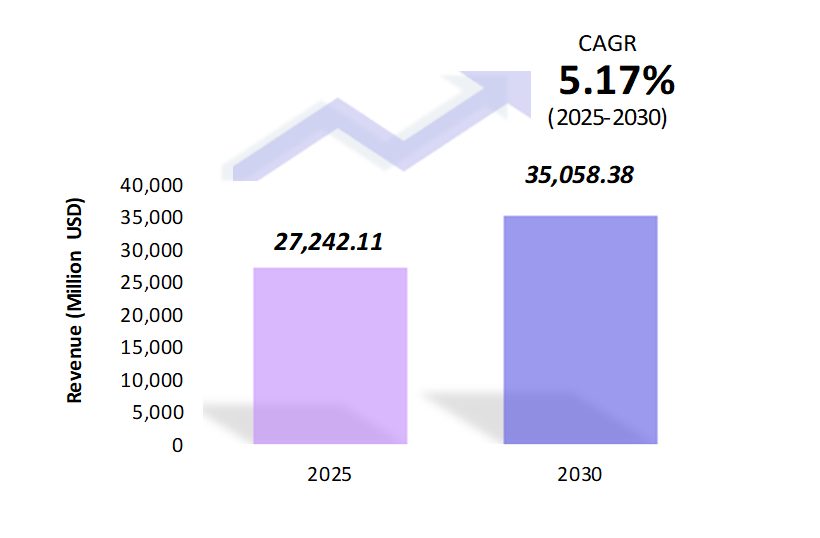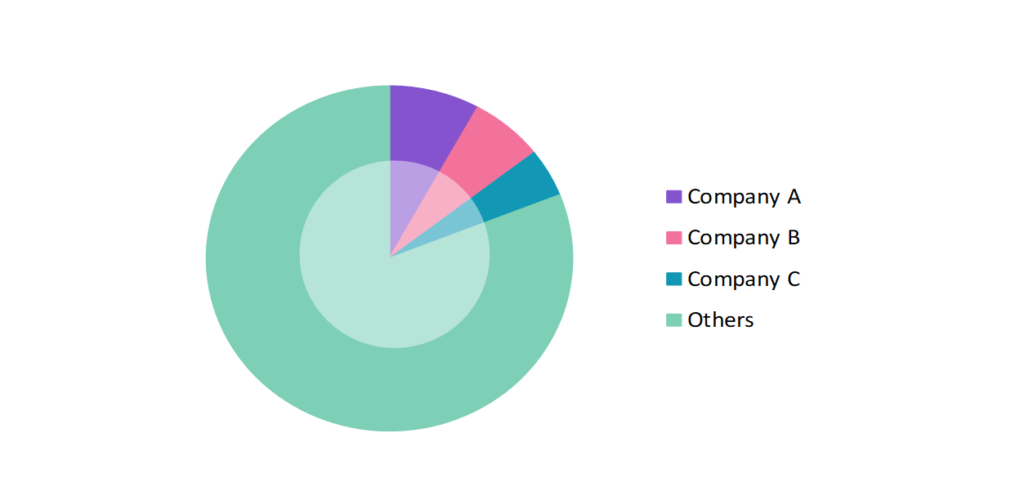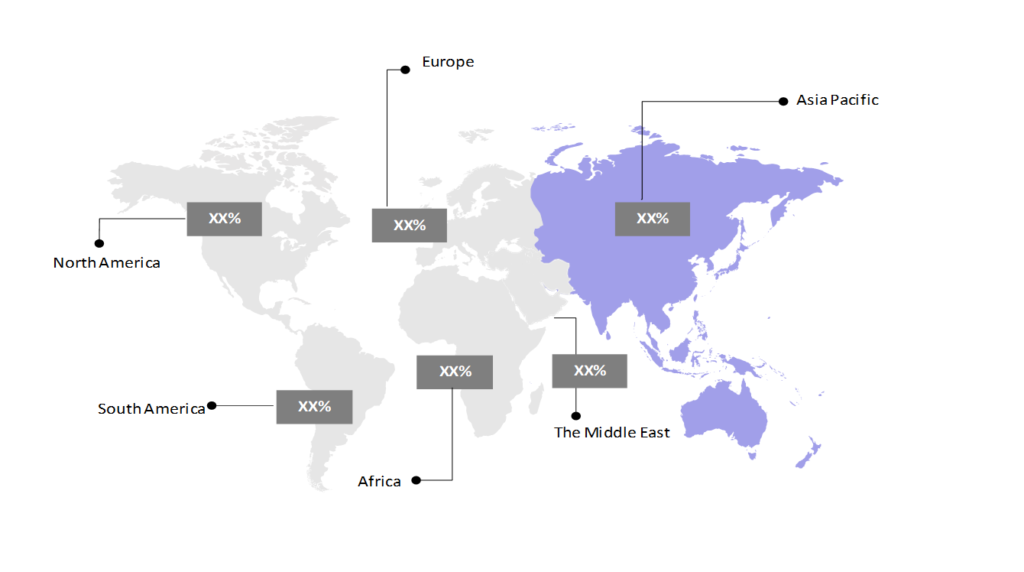Automotive Brake Systems Market Outlook: Size, Share, Trends & Growth Analysis (2024-2029)
The market report provided a comprehensive analysis segmented by Type (Disc Brake, Drum Brake); by Component (Master Cylinders, Brake Pads, Brake Shoes, Brake Calipers, Brake Disc Rotors); by Vehicle Type (Passenger Cars, Light Commercial Vehicles, Trucks, Buses); by Geography (North America, South America, Asia Pacific, Europe, The Middle East, Africa).
Outlook

- The automotive brake systems market is estimated to be at USD 27,242.11 Mn in 2025 and is anticipated to reach USD 35,058.38 Mn in 2030.
- The automotive brake systems market is registering a CAGR of 5.17% during the forecast period 2025-2030.
- The automotive brake system market is experiencing steady growth driven by increased safety regulations, technological advancements, and the rise of electric and autonomous vehicles. Demand for high-performance and advanced braking systems, including electronic and regenerative brakes, is expanding across passenger and commercial vehicle segments. Challenges such as high development costs and maintenance needs for advanced systems, however, pose obstacles. Nonetheless, the push for safer, more efficient braking solutions in both on-road and off-road applications continues to fuel market innovation and expansion.
Request a free sample.
Ecosystem

- The participants in the global automotive brake systems industry are always developing their strategies to preserve a competitive advantage.
- Companies are increasingly investing in innovations like electronic braking systems, regenerative braking, and AI-driven safety features to cater to the rising demand for advanced safety and efficiency, giving them a competitive edge.
- Several important entities in the automotive brake systems market include Continental AG; Robert Bosch GmbH; ZF Friedrichshafen AG; Akebono Brake Industry Co., Ltd.; Brembo S.p.A.; and others.
Ask for customization.
Findings
| Attributes | Values |
|---|---|
| Historical Period | 2019-2023 |
| Base Year | 2024 |
| Forecast Period | 2025-2030 |
| Market Size (2025) | USD 27,242.11 Mn |
| Market Size (2030) | USD 35,058.38 Mn |
| Growth Rate | 5.17% CAGR from 2025 to 2030 |
| Key Segments | Type (Disc Brake, Drum Brake); Component (Master Cylinders, Brake Pads, Brake Shoes, Brake Calipers, Brake Disc Rotors); Vehicle Type (Passenger Cars, Light Commercial Vehicles, Trucks, Buses) Geography (North America, South America, Asia Pacific, Europe, The Middle East, Africa) |
| Key Vendors | Continental AG; Robert Bosch GmbH; ZF Friedrichshafen AG; Akebono Brake Industry Co., Ltd.; Brembo S.p.A. |
| Key Countries | The US; Canada; Mexico; Brazil; Argentina; Colombia; China; Singapore; India; Japan; Germany; Italy; France; Netherlands; Turkey; UAE; Saudi Arabia; Egypt; South Africa |
| Largest Market | Asia Pacific |
Get a free quote.
Trends
- Regenerative Braking Integration: Electric and hybrid vehicles are increasingly adopting regenerative braking systems, which convert kinetic energy back into stored energy for the battery. Innovations include adaptive regenerative braking that dynamically adjusts based on driving patterns, maximizing efficiency and energy recovery in both urban and highway settings.
- Use of Predictive Emergency Braking (PEB): Modern braking systems use AI (artificial intelligence) and sensors to predict collisions, automatically applying brakes if the driver does not react in time. Newer PEB systems can analyze complex traffic scenarios, distinguishing between vehicles, pedestrians, and cyclists, enhancing safety in urban environments with heavy foot traffic. Tesla’s Automatic Emergency Braking (AEB) system leverages onboard AI and a suite of sensors, including cameras, radar, and ultrasonic sensors, to monitor the surroundings and predict potential collisions.
- Adoption of Carbon-Ceramic Brake Discs: High-performance vehicles are adopting lightweight carbon-ceramic brake discs, which are resistant to extreme temperatures and provide consistent performance. These discs are now being developed for mass-market vehicles, which reduce wear, improve fuel efficiency, and offer enhanced longevity over traditional metal brake discs. Porsche has adapted Porsche Surface Coated Brake (PSCB) technology for models like the Cayenne and Panamera, bridging the gap toward more mainstream luxury and family-oriented vehicles.
Speak to analyst.
Catalysts
- Increased Emphasis on Road Safety: Governments and automotive safety organizations worldwide are pushing for safer road conditions, leading to stringent brake performance standards. This emphasis drives innovations in brake systems that reduce stopping distance and improve overall vehicle stability, especially for both passenger and commercial vehicles. Safety-focused advancements, such as adaptive braking and electronic stability control, are being incorporated into more vehicles to meet these rising standards.
- Strict Government Lows for shorten Stopping Distances: Governments are introducing regulations requiring shorter stopping distances for both light-duty and heavy-duty vehicles. For instance, in regions like the EU and the US, commercial vehicles must comply with tighter braking performance standards to reduce the risk of accidents. These regulations are fueling demand for advanced brake systems, such as enhanced disc brakes, anti-lock braking systems (ABS), and automatic emergency braking (AEB), which push manufacturers to innovate to meet compliance.
- Growth in Demand for Off-Highway Heavy-Duty Trucks: The expanding construction, mining, and agricultural sectors are increasing the demand for off-highway heavy-duty trucks. These vehicles operate in challenging terrains and require robust braking systems to ensure safety and reliability under heavy loads. Consequently, there is a surge in demand for high-performance braking solutions, including regenerative braking and anti-lock systems tailored for off-road use, to enhance durability and operational safety in these high-demand applications.
Inquire before buying.
Restraints
- Malfunctioning of Electronic Braking Systems: Electronic braking systems (EBS) introduce complexities that can lead to malfunctions, often due to software or sensor failures. Such issues pose significant safety risks, especially in critical driving situations. Additionally, diagnosing and repairing electronic malfunctions can be challenging and costly, impacting both vehicle downtime and customer trust in these systems.
- Freezing of Air Brakes at Low Temperatures: Air brakes, commonly used in heavy-duty vehicles, are prone to freezing in low-temperature environments, which can impair braking performance or even lead to complete brake failure. This challenge is especially relevant in regions with harsh winters, where maintaining air brake functionality requires additional components, such as air dryers and antifreeze additives, increasing maintenance demands.
- High Development and Maintenance Costs of Advanced Braking Systems: Advanced braking technologies, like regenerative braking, adaptive braking, and electronic stability control, involve substantial development and manufacturing costs. These systems also require specialized maintenance, which can increase the total cost of ownership for vehicle operators and manufacturers. This cost factor can hinder widespread adoption, particularly in budget-conscious markets where affordability remains a priority.
Personalize this research.
Hotspot

Explore purchase options.
Table of Contents
| 1. Introduction 1.1. Research Methodology 1.2. Scope of the Study 2. Market Overview / Executive Summary 2.1. Global Automotive Brake Systems Market (2019 – 2023) 2.2. Global Automotive Brake Systems Market (2024 – 2030) 3. Market Segmentation 3.1. Global Automotive Brake Systems Market by Type 3.1.1. Disc Brake 3.1.2. Drum Brake 3.2. Global Automotive Brake Systems Market by Components 3.2.1. Master Cylinders 3.2.2. Brake Pads 3.2.3. Brake Shoes 3.2.4. Brake Callipers 3.2.5. Brake Disc Rotors 3.3. Global Automotive Brake Systems Market by Vehicle Type 3.3.1. Passenger Cars 3.3.2. Light Commercial Vehicles 3.3.3. Trucks 3.3.4. Buses 4. Regional Segmentation 4.1. North America 4.1.1. The US 4.1.2. Canada 4.1.3. Mexico 4.2. South America 4.2.1. Brazil 4.2.2. Argentina 4.2.3. Colombia 4.2.4. Rest of South America 4.3. Asia Pacific 4.3.1. China 4.3.2. Singapore 4.3.3. India 4.3.4. Japan 4.3.5. Rest of Asia Pacific 4.4. Europe 4.4.1. Germany 4.4.2. Italy 4.4.3. France 4.4.4. Netherlands 4.4.5. Rest of Europe 4.5. The Middle East 4.5.1. Turkey 4.5.2. UAE 4.5.3. Saudi Arabia 4.5.4. Rest of the Middle East 4.6. Africa 4.6.1. Egypt 4.6.2. South Africa 4.6.3. Rest of Africa 5. Value Chain Analysis of the Global Automotive Brake Systems Market 6. Porter Five Forces Analysis 6.1. Threats of New Entrants 6.2. Threats of Substitutes 6.3. Bargaining Power of Buyers 6.4. Bargaining Power of Suppliers 6.5. Competition in the Industry 7. Trends, Drivers and Challenges Analysis 7.1. Market Trends 7.1.1. Market Trend 1 7.1.2. Market Trend 2 7.1.3. Market Trend 3 7.2. Market Drivers 7.2.1. Market Driver 1 7.2.2. Market Driver 2 7.2.3. Market Driver 3 7.3. Market Challenges 7.3.1. Market Challenge 1 7.3.2. Market Challenge 2 7.3.3. Market Challenge 3 8. Opportunities Analysis 8.1. Market Opportunity 1 8.2. Market Opportunity 2 8.3. Market Opportunity 3 9. Competitive Landscape 9.1. Continental AG 9.2. Robert Bosch GmbH 9.3. ZF Friedrichshafen AG 9.4. Akebono Brake Industry Co., Ltd. 9.5. Brembo S.p.A. 9.6. Company 6 9.7. Company 7 9.8. Company 8 9.9. Company 9 9.10. Company 10 |
Know the research methodology.
Automotive Brake Systems Market – FAQs
1. What is the current size of the automotive brake systems market?
Ans. In 2025, the automotive brake systems market size is USD 27,242.11 Mn.
2. Who are the major vendors in the automotive brake systems market?
Ans. The major vendors in the automotive brake systems market are Continental AG; Robert Bosch GmbH; ZF Friedrichshafen AG; Akebono Brake Industry Co., Ltd.; Brembo S.p.A.
3. Which segments are covered under the automotive brake systems market segments analysis?
Ans. The automotive brake systems market report offers in-depth insights into Type, Component, Vehicle Type, and Geography.
